Zion, Bryce and the Grand Canyon: a summary 

In july and august 2000, Wouter, Karin, Pieter, Ernst and me went to the US. After a first week in New York, we flew to Las Vegas, and drove to Zion.
We camped at the rim of the Grand Canyon, and finally got into Bryce Canyon.
Las Vegas

We arrived at night in Vegas. Of course we took the Strip with the Ford Explorer. I must say, when you stay in your car and admire the lights,
Vegas at night is quite a fairytale.
There are more photographs of Vegas by night on the Dutch
nl Day 1.
But the nicest thing about Vegas is, that when you leave the city, by the North Shore Scenic Drive, you are in the desert. This desert is not the big sandpit that I always have associated with the word desert; this desert is rocky, with hills in every colour imaginable.
Zion

When we have entered Arizona, and a few minutes later Nevada, the Virgin River shows the great canyons it has carved, in the marvelous curves of the road. The stream itself is small and muddy: you never would have dreamed that it's responsible for the canyons you drive through.
This muddy stream, or, more exactly, its North and East Forks, is also responsible for Zion Canyon. We didn't "do" Zion by shuttle, but took the Kolob Reservoir Road to Lava Point overlook, where you look, as it where, over the canyon, from the side.
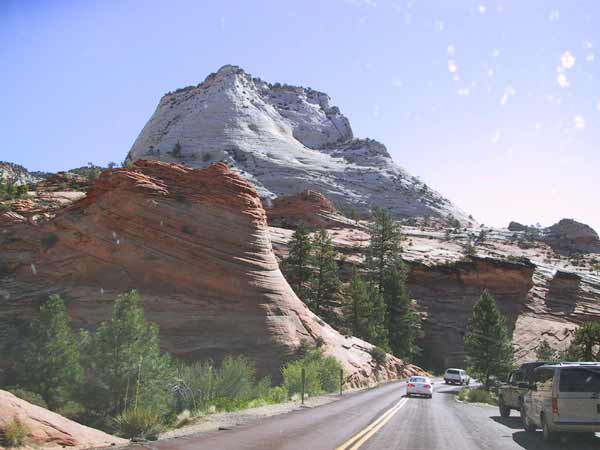
We dined and slept at Flanigan's Inn, and explored the East Fork the following morning. The mountains here are volcanous, which explains the bizarre forms and surfaces. It's "Oh" and "Ah" country here, and you really should take a look at the photographs at the Dutch nl Day 2 and nl Day 3 .
Pink Sand Dunes
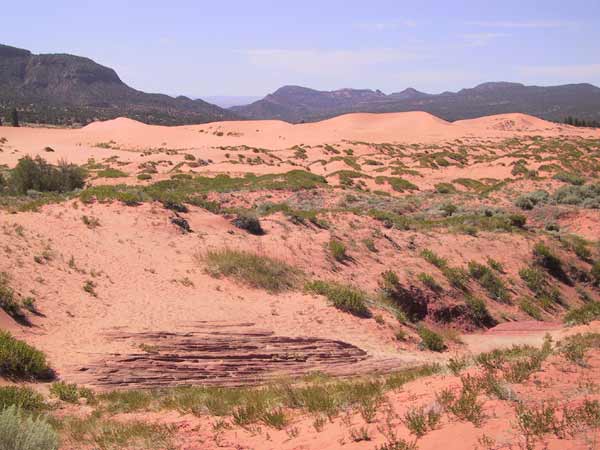
As you see, the Pink Sand Dunes really are exactly what their name suggests. The sand is eroded from the red rock country of the four corners, is blown through a narow gap in the cliffs by the wind, and assembled in dunes in this area.
It's very soft on your bare feet!
More pictures on nl Day 3 .
Pipe Springs Monument

Pipe Springs Monument, in Paiute Country, was a very nice suprprise.
A Paiute is your guide in a house and barns where in yesteryears Mormones lived. The Paiute had lived there, a couple of hundreds of years ago, but had fled for the Spaniards.
The Mormons believed that Indians had a dark skin because they had fallen from the true belief, and were very keen on converting them. A number of 600 Paiutes lived here, but there was not enough food, and only 69 of them survived...
The Mormons took very young Indiand girls as second or third wives (there is still a lot of Indian blood in many Mormons).
All in all, I couldn't imagine this place had good memories for the Paiute, but, as our guide told us, at least some of the intentions of the Mormones were good, which can't be said of the Spaniards.
It was a beautiful, simple place to look around, with a very friendly guide who really knew the history of the place, and somehow, I liked the fact that it was part of Paiute country today.
More photographs on nl Day 3.
Toroweap

The unpaved Mount Trumbull Loop took us to the rim of the Grand Canyon at Toroweap. The road was superb: getting rougher and rougher, and we encountered no more than one other vehicle.
Camping on the rim of the Grand Canyon is something I would wish for everybody. Somehow, you sense the superhuman dimensions of the incredibly deep canyon, only thirty or forty meters from where you sleep.

And the following morning, you are treated on breathtaking colours when you are looking over the rim.
More photographs on nl day 4...
North Rim of the Grand Canyon
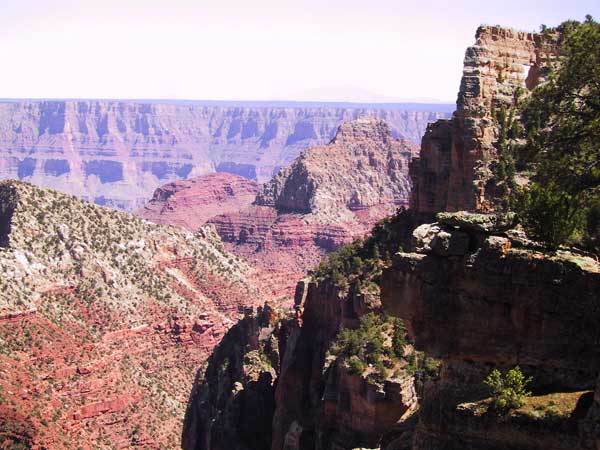
After Toroweap, the North Rim of the Grand Canyon has less magic. The Grand Canyon is deeper and much wider at that point, but it can't beat a night alone at the rim!
More pictures on nl day 4
Cliff Dwellers
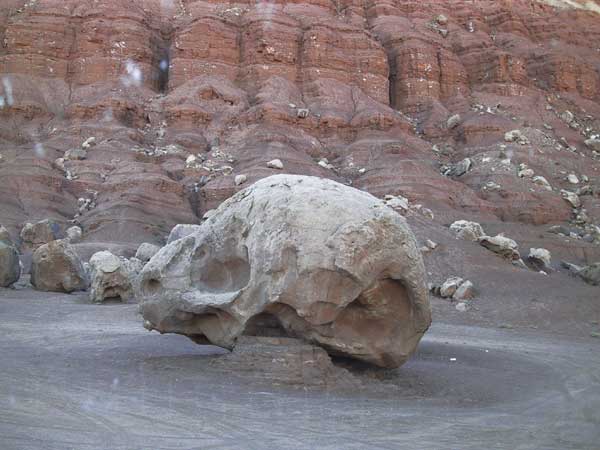
At the foot of the Vermillion Cliffs, near Page, you find Cliff Dwellers, a set of strangely formed rocks. Some of them are used as walls for a trading post, and some are just there to be admired...
Johnson Canyon

Johnson Canyon road is a dirtroad, which we took to get from Kanab to Bryce. The road takes you through a multicoloured landscape, with even bright yellow rocks.
This is what I like most: a road from which you didn't expect anything particular, which turns out to be breathtaking. Far better actually than the Kodachrome Basin, which was on the other side of Jognson Canyon. If you like fallus symbols, you should go there. Yes, they are strange and particular, but in beauty they don't get close to the surroundings of Johnson Canyon.
More photographs on nl day 5.
Bryce Canyon
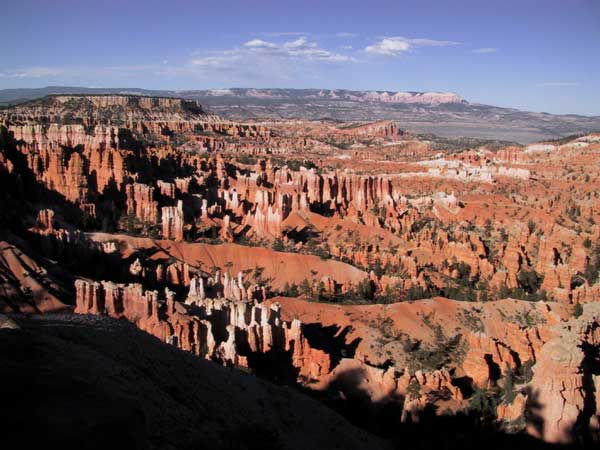
It's almost impossible to say something about Bryce: you just have to see it. There are amphitheatres of red and pink and white and orange rocks. For the Indians, they looked like human figures. To me, they looked like medieval cities, with cathedrals and townwalls.
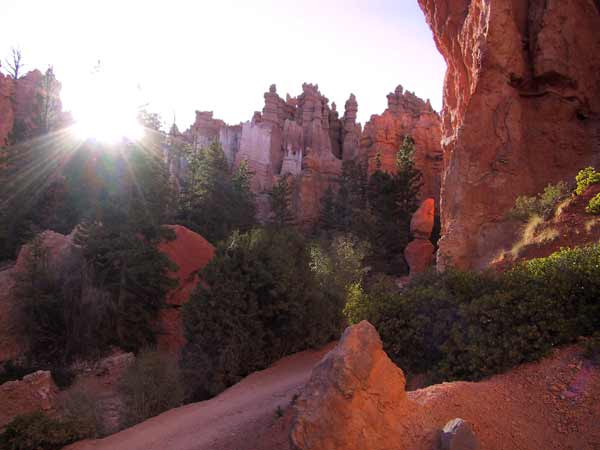
It's just incredibly beautiful, that's all there is to say.
More photographs on nl day 5 and on nl day 6
Burr Trail
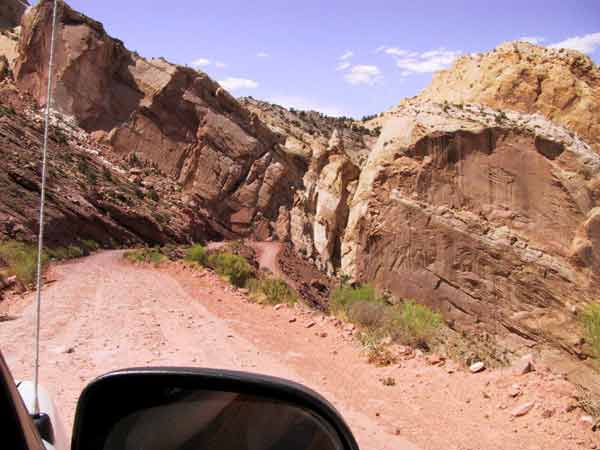
Even after Bryce, the Burr Trail was a highlight as well, with these hairpins to overcome the Waterpocket Fold, and blue, yellow, red and green mountains everywhere.
More photographs on nl day 6
Copyright 1993-now.
For comments, e-mail adress: sylviastuurman@gmail.com